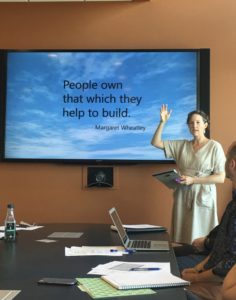When working with groups, I like to begin with Margaret Wheatley’s observation, “People own that which they help to build.” It neatly sums up the monumental shifts that can occur when we embrace a core truth of community building:
Engaging community in the process of change work is fundamental to design, impact and sustainability.
This is hardly new news. Practitioners of collective impact regularly strive to engage community in their work. We get the why of engagement – it’s the how of community engagement that presents challenges.
A few things first. I encourage teams to think of community as an ecosystem of people, organizations and patterns of interactions. I ask them to “get up on the balcony” to see the network of patterns and behaviors, ways that people, businesses and organizations navigate their community. This allows teams to see where they can leverage existing momentum, and where to anticipate roadblocks.
To overlook what is, what’s working and why some things seem stuck, is to risk triggering harmful “unintended consequences” – ripple effects we don’t anticipate when we introduce change.
Because in the end, no matter what our change effort is – expanding early childhood opportunities, addressing our changing climate at the local level, launching an anti-poverty organizing project – we must strive to do no harm. This is especially true in rural communities, which often develop subtle patterns in light of scarce resources and tremendous need.
The only way I have seen to address these concerns – inadvertently disrupting fragile community networks, triggering harmful unintended consequences, or simply designing something that has little to no real impact – is to meaningfully engage people in the work.
Here are two ways I’ve recently worked with groups to ensure that people are actively helping to build that which they then own.
Launching a community coalition
A group of volunteers contacted me to help form a coalition to mitigate their community’s contribution to climate change. Rather than encourage them to build an action plan, establish a c3 and announce a launch, I am coaching them through the Collaborative Innovation Roadmap developed by CoCreative Consulting. The initial steps of the roadmap are to form a design team which reaches out to community members in a series of interviews. After the design team does some sense-making from the interviews, they will convene a larger group to advance collective understanding of the work and to prioritize areas of focus. This process is both fun and informative, and helps course correct on assumptions and missed opportunities early in the development of the initiative.
Launching a statewide workforce development network
I recently designed two planning sessions for practitioners who hope to increase coordination of state- and local-level workforce training. During the first meeting, participants began prioritizing trainings most needed, and brainstorming innovative ways to deliver trainings in rural areas.
At the second gathering, new folks were invited to the discussion, people who work in other sectors, or who work on the ground in communities. They quickly questioned why the group was about to – potentially – make the problem worse by providing more trainings. They recommended that the network engage a broader set of practitioners and communities before determining the path forward. This refocus was welcomed by the network, and they will spend this next year reaching out to key stakeholders to help prioritize the trainings that are in most urgent need of better coordination.
In each of these initiatives, the process of engaging their community before settling on a specific set of strategies is better positioning the work.
It’s helping to deepen teams’ understanding of what is and what can be, and it’s setting up initiatives that will have broader community participation and, hopefully, deeper impact.
When we enter into this work with humility and a beginner’s mind, willing to learn and to discover new connections, we begin to see that engaging a broader set of players is not merely a good idea. Indeed, it’s often the make-or-break in the success of our endeavors. Let me know what you think.

